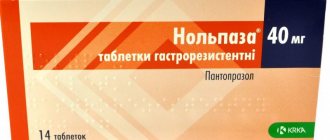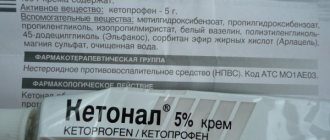Pharmacological properties of the drug Omnic ocas
Pharmacodynamics. Tamsulosin selectively and competitively blocks postsynaptic α1-adrenergic receptors, especially α1A and α1D subtypes located in the smooth muscles of the prostate gland, bladder neck, prostatic urethra and detrusor. This causes a decrease in the tone of the smooth muscles of the prostate gland, bladder neck and prostatic urethra and an improvement in urine outflow. At the same time, the severity of symptoms of obstruction (emptying) and irritation (filling) of the bladder associated with benign prostatic hyperplasia decreases. The described effect of the drug on symptoms of obstruction and irritation persists with prolonged use. The ability of α1A-adrenergic receptor blockers to reduce blood pressure is associated with a decrease in peripheral vascular resistance. Omnic Okas in a daily dose of 0.4 mg does not cause a clinically significant decrease in systemic blood pressure both in patients with hypertension (arterial hypertension) and with normal initial blood pressure. Pharmacokinetics. Absorption. Omnic Okas is a prolonged-release tablet with a controlled release of the active substance based on a matrix using a non-ionic gel. This dosage form provides a prolonged and slow release of tamsulosin, which ensures exposure of the active substance with minor fluctuations over 24 hours. After oral administration, 57% of tamsulosin is absorbed in the intestine. The rate and extent of absorption do not depend on food intake. Tamsulosin has linear pharmacokinetics. After a single dose of Omnic Okas on an empty stomach, the maximum concentration of the active substance in the blood plasma is achieved after 6 hours. In the equilibrium state, which is achieved on the 4th day of taking the drug, the maximum concentration is observed after 4-6 hours, regardless of food intake. The maximum plasma concentration increases from 6 ng/ml after the first dose to 11 ng/ml at steady state. As a result of prolonged release, the minimum plasma concentration of tamsulosin is 40% of the maximum concentration, regardless of food intake. Distribution . Plasma protein binding - 99%. The volume of distribution is insignificant - up to 0.2 l/kg body weight. Metabolism. Tamsulosin hydrochloride is not subject to the first pass effect through the liver and is slowly metabolized in the liver to form pharmacologically active metabolites that retain high selectivity for α1A-adrenergic receptors. Most of the active substance is found in the blood unchanged. Excretion. Tamsulosin hydrochloride is excreted in the urine, 4–6% unchanged. The half-life of tamsulosin with a single dose and at steady state is 19 and 15 hours, respectively.
Analogs
When choosing an analogue of Omnic Okas, you can note drugs that have the same active substance, i.e. tamsulosin, or medications that have the same effect. The first group of medications includes:
- Adenorm. It is a hard gelatin capsule containing tamsulosin. Additionally, the composition includes spherical sugar, cetyl alcohol, talc, povidone. Refers to alpha1-adrenergic receptor antagonists. The effect of the drug is due to a decrease in the tone of the prostatic part of the urethra.
- Proflosin. Another option for extended-release capsules. The intestines completely dissolve them. In addition to the same active ingredient, it contains yellow oxide, ethyl acrylate copolymer, talc, titanium dioxide, indigo carmine. In addition to correcting urodynamics, the drug regulates the metabolism of the prostate gland.
- Sonizin. The excipients of this drug are calcium stearate, copolymer of methacrylic acid and ethyl acrylate, MCC, talc. The medicine is presented in capsules with a soluble gelatin shell. It has the same indications and contraindications as Omnic.
- Focusin. Also capsules in a gelatin shell with the main active ingredient in the form of tamsulosin. Additionally, the composition includes dibutyl sebacate, silicon dioxide, talc, microcrystalline cellulose. The drug is a representative of the group of alpha-blockers.
Among the drugs that have the same principle of action are Dalfaz, Setegis, Avodart. These medications are often used in the complex treatment of prostate adenoma. They are prescribed together with alpha-blockers to enhance effectiveness. The operating principle of these analogues is the same. The drugs affect the smooth muscles of the prostate gland, thereby improving urodynamics.
Side effects of the drug Omnic ocas
Common side effects (1% but ≤10%) are dizziness (1.3%). Uncommon side effects (0.1%, but ≤1%) are headache, tachycardia, postural hypotension, rhinitis, constipation, diarrhea, nausea, vomiting, rash, urticaria, itching, retrograde ejaculation, asthenia. Rare side effects (0.01%, but ≤0.1%) are fainting, angioedema. Very rare (≤0.01%) - priapism. Cases of intraoperative instability of the iris (narrow pupil syndrome) during cataract surgery in patients taking tamsulosin for a long time have been described.
Indications for use
The drug Omnic Okas is used in the treatment of key dysuric disorders of various etiologies. Basically, urologists prescribe tamsulosin-based tablets to treat complications of benign prostatic hyperplasia (prostate adenoma). But in the treatment of prostatitis, the drug is also quite effective if the patient suffers from problems with the urinary system.
Some modern studies of the drug Omnic Okas as a medicine for prostatitis and prostate adenoma have additionally shown its promise in the symptomatic treatment of urolithiasis.
Special instructions for the use of the drug Omnic ocas
Like other α1-adrenergic receptor blockers, Omnic Ocas should be used with caution in patients with a tendency to orthostatic hypotension. At the first symptoms of orthostatic hypotension (dizziness, weakness), the patient should be seated or laid down. During surgery for cataracts while taking the drug, intraoperative instability of the iris (narrow pupil syndrome) may develop, which should be taken into account by the surgeon during the preoperative preparation of the patient and the operation. Before starting treatment and regularly during therapy, a digital rectal examination should be performed and, if necessary, a specific prostate antigen (PSA) should be determined in the blood. Patients with impaired renal function do not reduce the dose of the drug; the drug is prescribed with caution to patients with creatinine clearance below 10 ml/min. There are no data on use in children. There is no evidence of adverse effects on the ability to drive vehicles or operate potentially dangerous machinery.
Operating principle
The action of the drug Omnic Okas is based on the fact that it selectively and competitively blocks alpha1-adrenergic receptors contained in three target areas of the male genitourinary system for BPH:
- smooth muscles of the prostate gland;
- muscles of the bladder neck;
- prostatic area of the urethra.
As a result, tamsulosin reduces the tone and spasmodic state of these organs and tissues, thereby increasing their permeability and normalizing the previously impaired outflow of urine from the bladder.
Being a urodynamic corrector, Omnic Okas also allows you to restore sexual dysfunction by reducing swelling of the prostate gland. However, the drug does not significantly affect blood pressure in hypertensive or normotensive patients. Additionally, the medicine eliminates the symptoms of filling and emptying - all of these effects persist even after the end of the course of use of the drug.
Interactions of the drug Omnic ocas
No interactions were observed with the simultaneous use of tamsulosin hydrochloride with atenolol, enalapril, nifedipine and theophylline. When the drug was used in combination with cimetidine, a slight increase in the concentration of tamsulosin in the blood plasma was observed, and with furosemide - a decrease in concentration, but this does not require a change in the dose of Omnica Ocas. Diazepam, propranolol, trichlormethiazide, chlormadinone, amitriptyline, diclofenac, glibenclamide, simvastatin and warfarin do not change the free fraction of tamsulosin in human plasma. Tamsulosin also does not change the free fractions of diazepam, propranolol, trichlormethiazide and chlormadinone. In vitro, there was no effect of tamsulosin on the level of metabolism of amitriptyline, salbutamol, glibenclamide and finasteride by microsomal liver enzymes. Diclofenac and warfarin may increase the rate of elimination of tamsulosin. Concomitant treatment with other α1-adrenergic receptor antagonists can lead to a pronounced increase in the hypotensive effect.
Composition and release form
The medicine for prostate adenoma Omnic Okas is available in tablet form. Each tablet is coated with a yellow or brownish film, with the manufacturer’s inscription “0.4” embossed on one side. These numbers, as intended by the pharmaceutical manufacturer, reflect the concentration of the active substance in each tablet. The role of such a component is the well-known alpha1-adrenergic blocker tamsulosin, which is supplemented in Omnic Okas with secondary components - magnesium stearate and two types of macrogol.
In addition, the film coating of the tablets contains several dyes and stabilizers, but these ingredients are not biologically active. As for packaging, each cardboard box can contain one or three blisters of tablets - a total of 10 or 30 pieces. You can buy the drug at a pharmacy only with a doctor's prescription.
Omnik Okas and Omnik: what is the difference
To answer the question of how Omnik differs from Omnik Okas, first of all, you need to look at the differences in their chemical composition. Thus, a simpler analogue based on tamsulosin is supplied with such minor substances as talc, gelatin, MCC, methacrylic acid, sodium, calcium and others.
A similar chemical structure determines the difference in the pharmacokinetics of the drug. Omnic Okas, unlike its cheaper competitor, is a drug not with a modified, but with a controlled release of an alpha1-blocker.
Overdose of the drug Omnic ocas, symptoms and treatment
Cases of acute overdose of the drug have not been described. Theoretically, after an overdose of the drug, there is the possibility of developing acute hypotension, which requires the administration of cardiotropic therapy, monitoring of the function of the cardiovascular system and renal function. To prevent further absorption of the drug, gastric lavage, the use of activated charcoal or an osmotic laxative are indicated. Dialysis is not advisable due to the significant binding of tamsulosin to plasma proteins.
Instructions for use Omnic Okas
The medication belongs to the group of alpha1-blockers. Its action is to block receptors responsible for relaxing the smooth muscles of the urinary organs. As a result of taking it, its tone decreases, which helps speed up the rate of urination. This reduces the symptoms of hyperplasia, which eliminates the need for surgical intervention.
The tablets are characterized by a controlled release of the active substance throughout the day. They are not compatible with alcohol. After just two weeks of use, the following positive effects are observed:
- urination is normalized;
- the lumen of the bladder neck increases;
- decreased resistance to urine flow;
- normalization of blood supply to the bladder and metabolism in its muscles;
- pressure in the urethra decreases.
Indications
The main and only indication for the use of Omnic Okasa is prostate adenoma, which causes urination problems. The drug is necessary to relieve symptoms of the disease such as:
- feeling of incomplete emptying of the bladder;
- dripping after urination;
- frequent urge to urinate, including at night;
- weakened stream of urine;
- difficulty starting to urinate;
- urgency to empty the bladder.
Dosage
You can take the medicine regardless of food, but it is better at the same time. There is no need to chew the tablet so as not to disrupt the standard order of drug release. The optimal dosage is 400 mcg per day. This is one tablet. Omnic capsules are also accepted. Dosage does not require adjustment in case of liver or kidney failure. The course of treatment is not limited or determined by the doctor.
Side effects
The drug has a number of side effects. The first of these is an allergic reaction to the components of the medication. It causes skin rash, asthenic condition, itching and even urticaria. In more severe cases, angioedema and small pupil syndrome are noted. Other side effects include:
- vomit;
- nausea;
- priapism;
- dizziness;
- rhinitis;
- ejaculation disorder;
- fainting;
- diarrhea;
- orthostatic hypotension;
- feeling of heartbeat;
- constipation.
There are no cases of acute overdose of the drug, but theoretically they are possible. As a result, acute hypotension may develop, which requires additional administration of cardiotropic therapy and ensuring normal renal function. But the patient is not prescribed dialysis, because tamsulosin combines with proteins in the plasma. An overdose may be manifested by tachycardia and decreased blood pressure.
- How long to cook shrimp after boiling. Shrimp cooking time
- How to transfer electricity meter readings to a personal account
- Dry cough in a child: treatment at home
In such a situation, it is important to prevent further absorption of the drug. To do this you need to induce vomiting. More gentle methods include gastric lavage, activated charcoal, or an osmotic laxative. All these measures, including symptomatic ones, prevent the drug from continuing to be absorbed and making you feel worse.
Contraindications
Not in all cases this medicine can be used to treat prostatic hyperplasia. It should be used with caution in chronic renal failure, arterial hypotension and severe impairment of renal function. The medicine is completely contraindicated for:
- severe liver failure;
- orthostatic hypotension;
- hypersensitivity to the components of the drug.
Omnic
Omnic (INN tamsulosin) is an alpha-1-blocker used for the correction of dysuric disorders in prostate adenoma from the Dutch pharmaceutical company Astellas Pharma Europe. Available in capsules. Selectively inactivates alpha-1 receptors located in the smooth muscle tissue of the pelvic organs - prostate, cervical bladder, prostatic area of the urethra. By reducing the excess tone of the smooth muscle “framework” of these tissue structures, normal evacuation of urine from the body through the urinary tract becomes possible. At the same time, obstructive manifestations and symptoms of irritation characteristic of prostate adenoma are leveled out. The therapeutic effect of the drug develops, as a rule, at the end of the second week from the start of the pharmacotherapeutic course. Omnic is a selective drug that interacts only to a small extent with the B subtype of alpha-1 adrenergic receptors, so it has virtually no effect on the level of systemic blood pressure, both in hypertensive patients and in individuals with normal initial blood pressure levels. After oral administration, Omnic is quickly and completely absorbed from the digestive tract. Peak plasma concentrations after taking the recommended single dose are achieved at 7 hours of tamsulosin's presence in the body. Metabolism of the active substance is slow. The half-life of the drug is 10 hours, and with regular course use it is 13 hours.
Excreted along with urine. Taken once a day after the morning meal. Side effects are relatively rare. These include vertigo, subjective tachycardia, headache, decreased appetite, and retrograde ejaculation. Contraindication to use is individual intolerance to tamsulosin. The drug should be used with caution in persons with liver disease and high blood pressure. The use of Omnic involves preliminary diagnosis to exclude diseases that have symptoms similar to prostate adenoma. Diagnostic testing includes rectal palpation and a blood test for prostate-specific antigen. In patients with kidney disease, no dose adjustment of Omnic is required. During treatment, activities that require attention and concentration should be minimized. Furosemide, when used together, somewhat suppresses the activity of Omnic, while cimetidine, on the contrary, increases it. Diclofenac accelerates the elimination of Omnic from the body. When using the drug together with other drugs from the alpha-1-blocker group, the antihypertensive effect may be enhanced, up to the point of fainting. At the first such signs, the patient should take a sitting or lying position and wait out the developed precollapse symptoms. Data on overdose with Omnic have not been reported in the medical literature to date.








